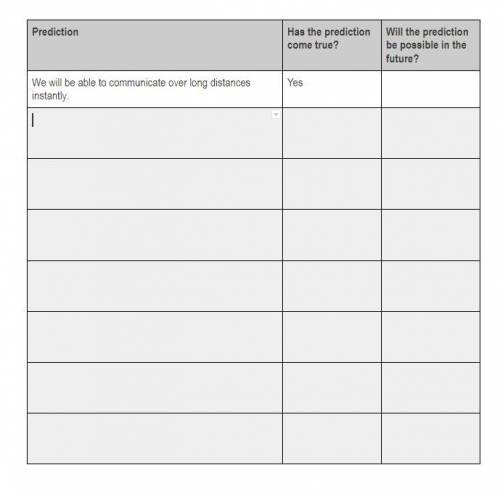Read these excerpts from three primary sources:
Source 1
This view of the future comes from J...

History, 04.06.2021 01:00 redbeast677
Read these excerpts from three primary sources:
Source 1
This view of the future comes from John Wilkins (1614–1672), an English clergyman, naturalist, and writer, who helped found the Royal Society for Natural Knowledge in England:
Yet I do seriously and on good grounds affirm it possible to make a flying chariot in which a man may sit and give such a motion unto it as shall convey him through the air. And this perhaps might be made large enough to carry diverse men at the same time, together with food for their viaticum and commodities for traffic. It is not the bigness of anything in this kind that can hinder its motion, if the motive faculty be answerable thereunto. We see a great ship swim as well as a small cork, and an eagle flies in the air as well as a little gnat.
Source: John Wilkins from A Discourse Concerning a New World and Another Planet, book 1, 1640
Source 2
Nikola Tesla (1856–1943) was a Serbian American inventor, scientist, engineer, and entrepreneur who worked with electricity and contributed to the development of alternating current. He made these predictions about the future:
It will soon be possible, for instance, for a business man in New York to dictate instructions and have them appear instantly in London or elsewhere. He will be able to call up from his desk and talk with any telephone subscriber in the world. It will only be necessary to carry an inexpensive instrument not bigger than a watch, which will enable its bearer to hear anywhere on sea or land for distances of thousands of miles. One may listen or transmit speech or song to the uttermost part of the world. In the same way any kind of picture, drawing, or print can be transferred from one place to another. It will be possible to operate millions of such instruments from a single station. Thus it will be a simple matter to keep the uttermost parts of the world in instant touch with each other. The song of a great singer, the speech of a political leader, the sermon of a great divine, the lecture of a man of science may thus be delivered to an audience scattered all over the world.
Source: Nikola Tesla, from an interview in the New York Times, Oct. 1909
Source 3
Isaac Asimov (1920–1992) was a famous author of hundreds of books about science, both fiction and nonfiction. He wrote the article from which these excerpts are taken after visiting the New York World’s Fair of 1964:
What will life be like, say, in 2014 AD, 50 years from now?
Gadgetry will continue to relieve mankind of tedious jobs. Kitchen units will be devised that will prepare "automeals," heating water and converting it to coffee; toasting bread; frying, poaching or scrambling eggs, grilling bacon, and so on. Breakfasts will be "ordered" the night before to be ready by a specified hour the next morning.
Much effort will be put into the designing of vehicles with "Robot-brains" vehicles that can be set for particular destinations and that will then proceed there without interference by the slow reflexes of a human driver.
However, by 2014, only unmanned ships will have landed on Mars, though a manned expedition will be in the works.
As for television, wall screens will have replaced the ordinary set; but transparent cubes will be making their appearance in which three-dimensional viewing will be possible.
All the high-school students will be taught the fundamentals of computer technology, will become proficient in binary arithmetic, and will be trained to perfection in the use of the computer languages that will have developed out of those like the contemporary "Fortran" (from "formula translation").
Source: Isaac Asimov, “A Visit to the World’s Fair of 2014,” New York Times, Aug. 16, 1964
Focus on some of the predictions given in sources 1, 2, and 3. Do you think any of them came true? Fill in the table to organize your observations. This will help you draw conclusions and write an essay in Part B. The first row of the table has been completed for you:


Answers: 2


Another question on History

History, 21.06.2019 17:50
Like ancient india, ancient china was generally ruled by a dynasty. which of these statements best describes this system of rule? a. rule of the country was passed down by inheritance. o b. rule of the country was voted on by the people. o c. rule of the country was decided by a committee of elders. o d. rule of the country changed hands through violent uprisings. submit
Answers: 3



History, 22.06.2019 05:00
After the french and indian war how did enland try to pay for the cost of the war
Answers: 2
You know the right answer?
Questions


Mathematics, 14.07.2019 14:00


Mathematics, 14.07.2019 14:00


Mathematics, 14.07.2019 14:00



Mathematics, 14.07.2019 14:00


Chemistry, 14.07.2019 14:00


Mathematics, 14.07.2019 14:00

Physics, 14.07.2019 14:00

Biology, 14.07.2019 14:00

Mathematics, 14.07.2019 14:00

Mathematics, 14.07.2019 14:00



Mathematics, 14.07.2019 14:00



